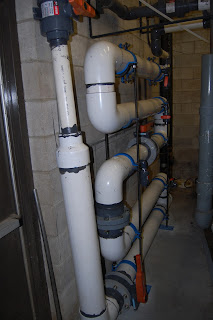 |
| Dust Control System Footprint |
 |
| Inlet Pressure Gauge |
Orchem had engineered and built a dust control system for the recycling center in Philadelphia that worked to perfection. It not only kept dust from drifting towards the neighbors when the "C & D" (construction & demolition) was being dumped, it also created a much safer and cooler work environment for the workers.
It worked so well in the current location they wanted to install one at the new facility, however the new building was 3 times larger than old one.
All off- loading of the C & D was to be done inside the plant which would create enormous dust clouds and a very difficult work space. The heavy equipment would be driving back and forth all day kicking up constant dust plumes.
Orchem designed a system that would be able to control dust so the workers could actually work inside. There is also a fine line between controlling dust and creating a giant, slippery mud puddle.
Utilizing very specific flow nozzles, set an exact distance apart, and with the proper pressure we can control all dust in the area.
The unit also had to be designed to control dust in 3 zones so there had to be a 3 zone manifold on the discharge of the pump to direct dust control only to the areas where it was needed.
I applaud the owners of this company. Since there is no concern with dust drifting off site to the neighbors, their only concern was for the workers inside the building. Safety and a good work atmosphere was first and foremost in their minds.
The complete dust control unit comes with;
Pressure switch for low water cut off
High flow pump coupled to a TEFC Baldor motor on a common base
2, 10 micron inlet cartridge filters
Inlet pressure gauge
Discharge pressure gauge
3 zone manifold with high pressure ball valves
Unloader/bypass valve
Control panel mounted in a NEMA 4x enclosure
Timer
Hand/auto/off switch
All associated piping and wiring, high pressure hydraulic hoses, fittings, tees, elbows, and nozzles.
 |
| Dust Control System Pumping Unit |
 |
| Inlet and dual cartridge filters |
 |
| Pressure switch for low water cut off |
 |
| Control Panel, NEMA 4X, Timer |
 |
| Unloader/Bypass valve with pressure gauge |













